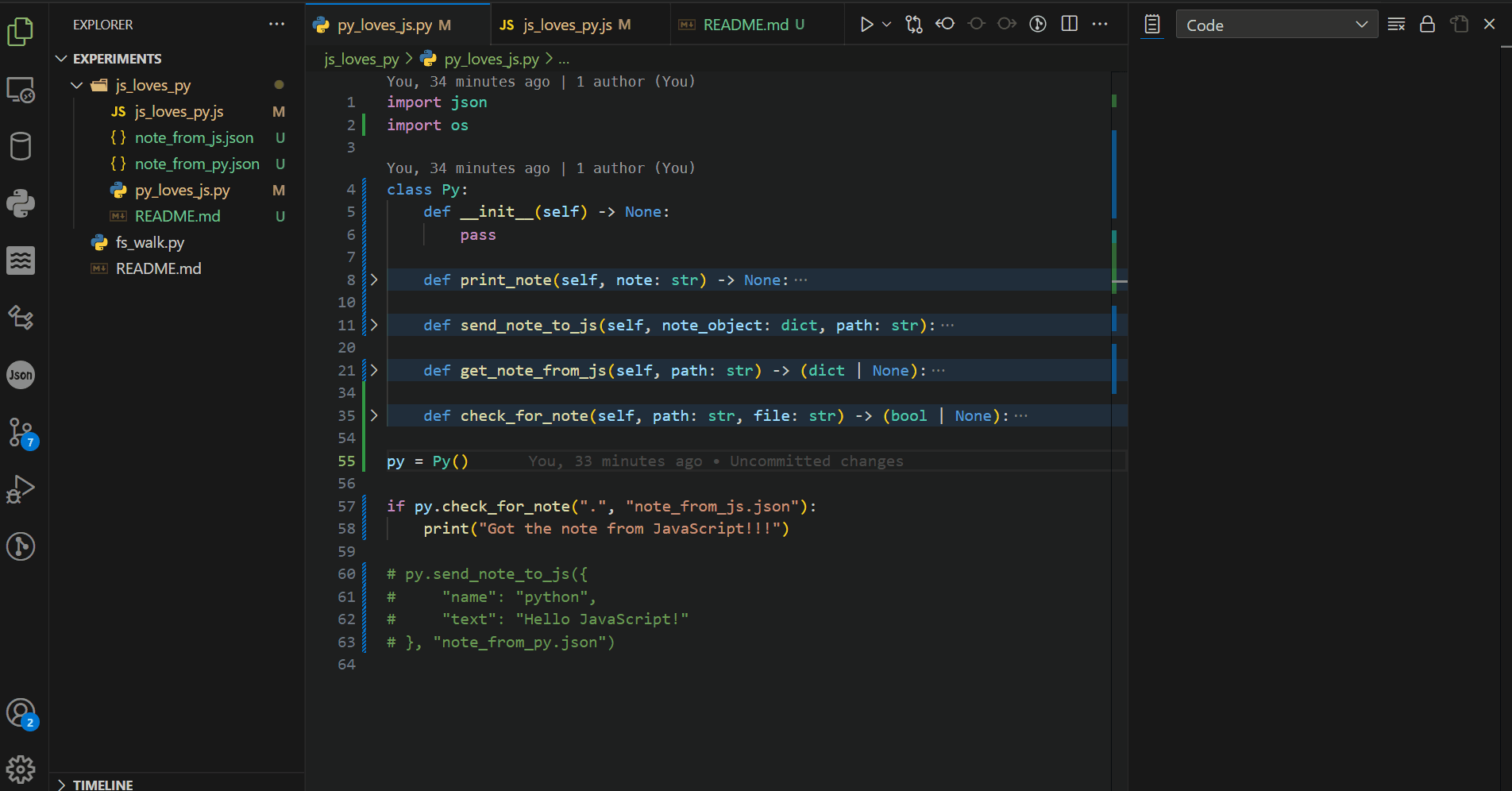JS Loves Py is a set of scripts that will allow you to easily pass data back and forth between JavaScript and Python using Json. I created this project to highlight this ability. It demonstrates one of many ways you can couple langauges together to work with one another. The ability to pass data back and forth between two languages like Python and JavaScript opens doors to a universe of new possibilities.
- Table of Contents
- About
- Usage
- Python & JavaScript Use Cases
- Benefits of Using JavaScript with Python
- Contributing
- Security
- Contacts
JS loves Py contains two classes. One in JavaScript called JS() and the other in Python call Py(). These two classes are identical other than the fact that one is written in Python and the other in JavaScript. Both classes allow you to pass an object back and forth between Python and JavaScript easily using Json. Each class creates a Json file which it will store the data being passed in. The Json files created by both classes are called from_js.json and from_py.json respectively.
Since Json, a JavaScript object and a Python dictionary all have the same syntax this can be leveraged to easily pass objects back and forth between Python and JavaScript (or really any language that can work with Json and/or has a similar object like structure {}). On top of that you can create listeners to automate getting the data being passed as I have here with the JS.checkForNote() and Py.check_for_note() methods.
All you have to do is specify the path to the place where the from_js.json and from_py.json files will be created by passing it to whichever listener is being used or both.
Heres an example of the listeners in both scripts in action. In this example I drag and drop the data files into the directory being listened to for the sake of time. You can see though that as I drop each file into the folder the output displays the contents.
In case you aren't familiar these are examples of Json, a JS Object and a Python dictionary to show that they all have the exact same syntax.
Json (JavaScript Object Notation)
{
"name": "json",
"msg": "Hello, world I'm Json"
}note = {
"name": "python",
"msg": "Hello, world I'm Python"
}let note = {
"name": "javascript",
"msg": "Hello, world I'm JavaScript"
}Both the JS and the Py classes have the exact same functionality and contain the same methods and properties as follows:
JS.NOTE- This is where the retieved data from Py is storedJS.JSON_PATH- This will store the path passed to checkForNote()JS.sendNoteToPy(note_object, path)JS.getNoteFromPy(path)JS.checkForNote(path)
Py.NOTE- This is where the retieved data from JS is storedPy.JSON_PATH- This will store the path passed to check_for_note()Py.send_note_to_js(self, note_object: dict, path: str)Py.get_note_from_js(self, path: str)Py.check_for_note(self, path: str, file: str)
To get an object from JavaScript to Python do the following:
- In your Python program create a new instance of the Py class and then call the
check_for_note()method passing in the path to watch and let it run.
py = Py()
py.check_for_note("C:\\MyPyApp\\")* NOTE * The
Py.check_for_noteandJS.checkForNotemethods both have the ability to detect the object/dict being sent from one another, so you can have thePy.checkForNoteor theJS.checkForNotemethod running already and when the object is sent and it will detect the json file, get the data object, and store it for you.
- Now in your JavaScript program create a new instance of the JS class and then call the
sendNoteToPy()method passing in the object containing whatever data you want as the first argument.
const js = new JS()
sendNoteToPy({
"title": "Note to Py from JS",
"text": "Hello Python!"
}, "note_from_js.json")Once the sendNoteToPy() method is called the object you passed in will be stored in the from_js.json file at the specified path and this will automatically be picked up on the Python side by the running Py.check_for_note() method from step 1. The data will be stored in the Py.NOTE property and accessible from there.
To get an object from Python to JavaScript do the same thing as in JS ➟ Py but in reverse as follows:
- In your JavaScript program create a new instance of the JS class and then call the
checkForNote()method passing in the path to watch and let it run.
js = JS()
js.checkForNote("C:\\MyPyApp\\")- Now in your Python program create a new instance of the Py class and then call the
send_note_to_js()method passing in the object containing whatever data you want as the first argument.
py = Py()
py.send_note_to_js({
"title": "Note to JS from Py",
"text": "Hello JavaScript!"
})Once the send_note_to_js() method is called the object you passed in will be stored in the from_py.json file at the specified path and this will automatically be picked up on the JavaScript side by the running JS.checkForNote() method from step 1. The data will be stored in the js.NOTE property and accessible from there.
Using Python and JavaScript together can be pretty powerful and flexible, as each language has its own strengths and use cases. Below are some common scenarios where combining Python and JavaScript can provide benefits:
- Backend (Python) and Frontend (JavaScript): Python can be used for server-side logic, data processing, and business logic, while JavaScript can handle dynamic content, user interaction, and frontend development.
- AJAX Requests: JavaScript can make asynchronous requests to Python backend APIs using technologies like AJAX (Asynchronous JavaScript and XML) to update specific parts of a webpage without requiring a full page reload.
- Python Data Processing + JavaScript Visualization Libraries: Python is often used for data processing and analysis using libraries like NumPy, pandas, and Matplotlib. Once data is prepared, it can be visualized using JavaScript libraries like D3.js, Plotly, or Chart.js for interactive and dynamic visualizations in web applications.
- Single Page Applications (SPAs): Using frameworks like Django (Python) for backend and React or Vue.js (JavaScript) for frontend allows developers to create seamless, efficient, and interactive SPAs where the two languages work together to deliver a cohesive user experience.
- Python Backend for Model Inference: Python's extensive machine learning and AI libraries like TensorFlow, PyTorch, and scikit-learn can be used to build and train models. JavaScript can then be used to deploy these models in web applications for real-time predictions and interactive user experiences.
- Python Backend + Electron (JavaScript) Frontend: Combining Python with Electron (a framework for building cross-platform desktop applications using web technologies) allows you to create desktop applications that have a Python backend and a JavaScript-based frontend.
- Embedding Interactive Elements: Python can be used to generate dynamic content or widgets, which can then be embedded in websites or content management systems using JavaScript. This is particularly useful for incorporating custom functionality or interactivity.
Programming is like art in a way. You're not locked into building specific things in specific ways, but rather you have the abilty to build what you want and how you want. Programming languages are flexible enough that you can do the same thing many different ways, whatever that thing your doing is. You can build a desktop app - frontend and backend - entirely with JavaScript, but I wanted to focus on using Python and JavaScript together so the following are some benefits I can think of.
Python is known for its data processing, scientific computing, and machine learning capabilities, while JavaScript is known for its ability to create interactive and dynamic user interfaces. By combining these strengths, you can create more feature-rich and interactive applications. As I mentioned previously, it opens up a lot of possibilities.
Both Python and JavaScript have vast ecosystems of libraries, frameworks, and tools. Combining them allows you to choose the best tools for each part of your application, optimizing for performance, functionality, and developer familiarity.
Using both languages enables you to address a wider range of challenges and create more versatile applications.
Separating backend logic (Python) from frontend presentation (JavaScript) follows the principle of separation of concerns, making your codebase more maintainable and easier to debug.
By splitting your application into backend and frontend components, you can scale each part independently based on demand, optimizing performance and resource usage.
If you have any feature requests, suggestions or general questions you can reach me via any of the methods listed below in the Contacts section.
Do not submit an issue or pull request: A general rule of thumb is to never publicly report bugs or vulnerabilities because you might inadvertently reveal it to unethical people who may use it for bad. Instead, you can email me directly at: [email protected]. I will deal with the issue privately and submit a patch as soon as possible.
Author: Paul M.
- Email: [email protected]
- Github: https://github.com/happycod3r
- Linkedin: https://www.linkedin.com/in/paul-mccarthy-89165a269/
- Facebook: https://www.facebook.com/paulebeatz

